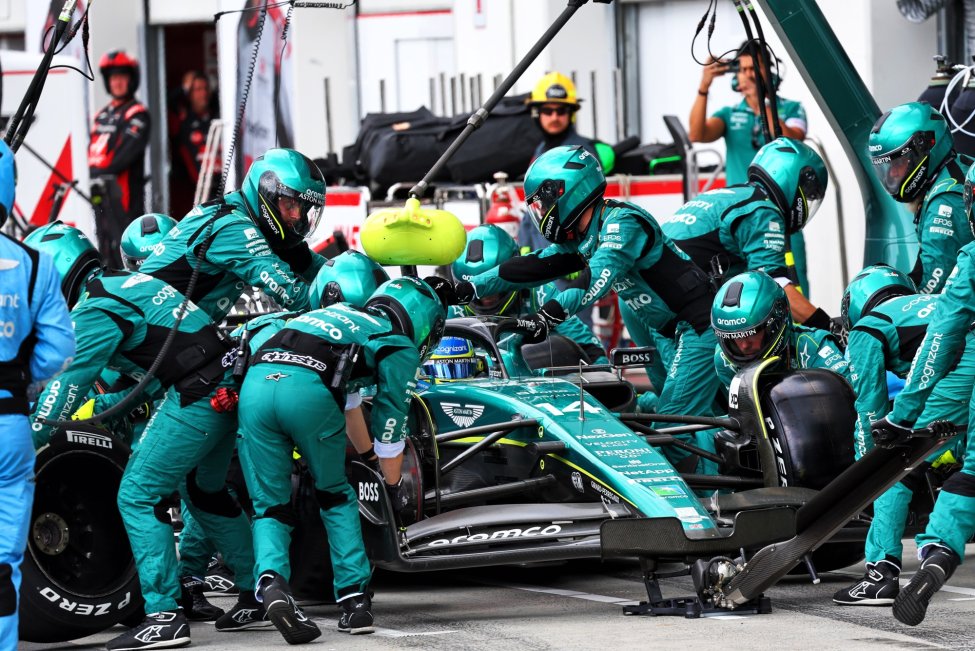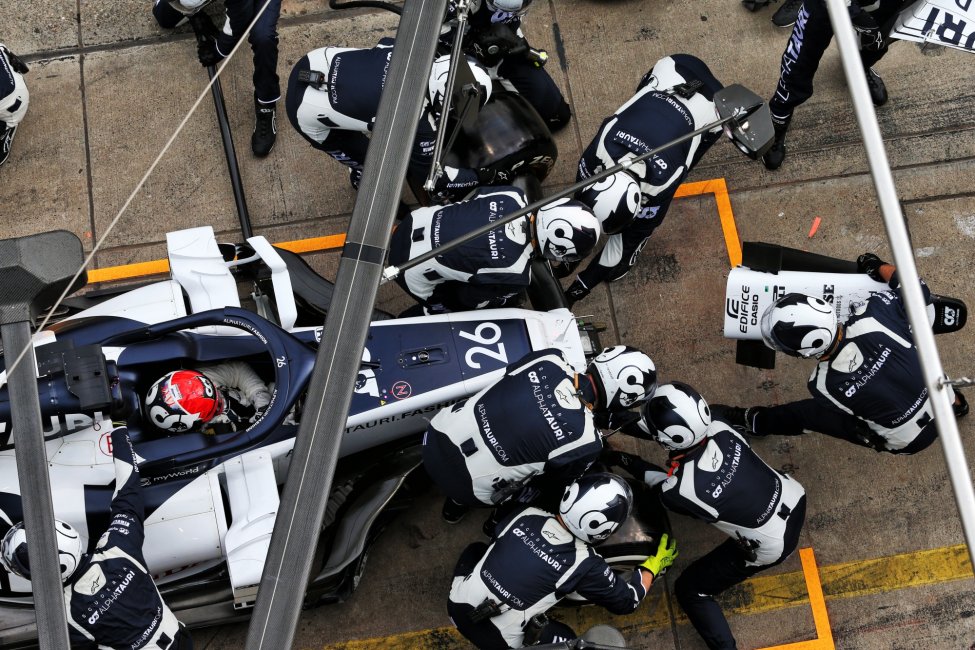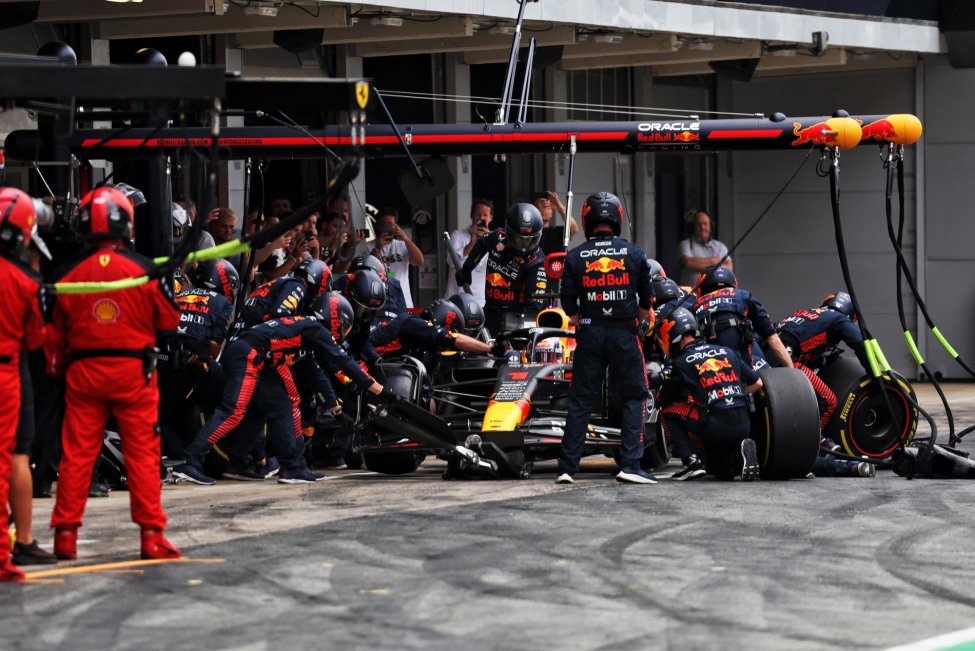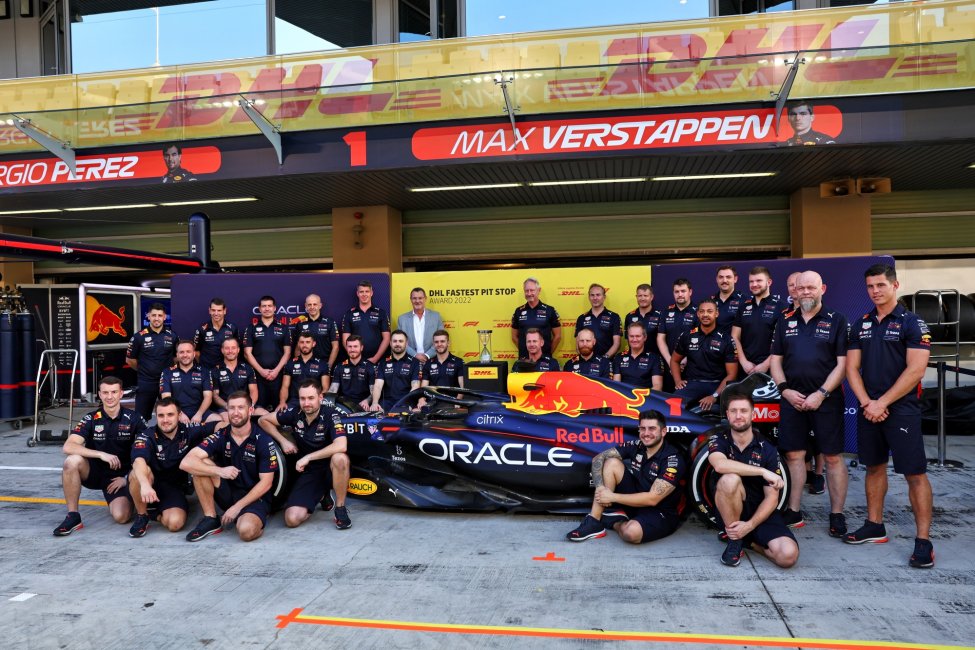F1 Pitstops explained & standings
How do F1 pitstops work? And what is the fastest pit stop ever made? You can find all the information on pit stops & the DHL standings for the fastest pit stops in Formula 1 here.
A pit stop in Formula 1 is a job in itself. It goes far beyond purely stopping and changing the tyres. A pit stop requires extreme precision and perfect teamwork to get the Formula 1 driver back on the track in the shortest possible time.
How does an F1 pit stop work?
A pit stop does not start only when the Formula 1 driver enters the pit lane, but well before. The team of strategists is busy prior to the pit stop to determine the right strategy. For this, the head of strategy communicates with several people who are often not even on the track, but in the factory. A huge amount of data is collected here and this is how the right strategy is calculated. After all, the timing of a pit stop can have a major impact on winning or losing a position or even the race.
When a Formula 1 driver is called in, he usually hears 'box, box' on his on-board radio. This means the Formula 1 driver has to drive to the pit lane. At that point, the entire pit stop team is already ready.
Is there a minimum or maximum time limit for a pit stop?
For pit stops, there is no maximum duration. However, new rules were introduced for pit stops in 2022 when the tires became larger (18 inches), making them heavier. To enhance safety, the FIA introduced a delay of 0.15 seconds between the moment the sensor detects that the tire is secured and when the software responds.
Additionally, there is a 0.20-second delay between pressing the wheel gun buttons and the moment the traffic light turns green. This prevents the team from signaling that the tires are secured before they are actually in place.
Due to criticism from teams, these delays were ultimately not implemented. Instead, it was agreed that a car can only depart when the team is certain everything is in place. To confirm this, teams must share pit stop data with the FIA.
There was speculation about a rule requiring a pit stop to last a minimum of 2 seconds, but this was never implemented by the FIA. While this rule is rarely broken, McLaren managed to execute a pit stop in less than 1.80 seconds in 2023.
DHL fastest pit stop standings 2025
| Team | Points |
|---|---|
| Ferrari | 264 |
| McLaren | 121 |
| Mercedes | 92 |
| Red Bull | 92 |
| Sauber | 84 |
| Racing Bulls | 81 |
| Alpine | 30 |
| Haas | 18 |
| Williams | 13 |
| Aston Martin | 13 |
What does the F1 pit crew look like?
To perform a pit stop, mechanics are trained to perform pit stops consistently, reliably and quickly. The pitstop team consists of about 20 people performing different tasks. This is the overview of the tasks and how many people are working on that task:
- Three people per tyre | One person removes the old tyre, the other puts the new tyre on and the last person loosens and fastens the tyre with a wheelgun. So with four tyres, you already need 12 people to perform this task.
- One person for the front jack | This is the mechanism used to lift the car at the front. Lifting an F1 car takes only a few hundredths of a second.
- One person for the rear jack | This is the mechanism used to lift the car at the rear. Did you know that the front and rear jack can cost tens of thousands of euros?
- One person ready with a spare jack
- Two people on each side of a Formula 1 car to keep the car straight and ensure stability
- Two people to adjust the front wing
- One person to check that the pit lane is clear so that the driver can drive off safely
- One person present with a fire extinguisher, in case fire breaks out
- Finally, there is one person present who can restart the car
Lollipop man
You used to have the so-called 'lollipop man' who performed various tasks during the F1 pit stop. This person held the team's pit sign (which was nicknamed the lollipop) so that the driver knew which pit box to stop at. The lollipop man also reminded the driver of several things, such as to hold the brakes during the tyre change and gave a sign to the driver when he was allowed to leave the pit lane. Nowadays, this works with a stoplight system.
What is also important during the pit stop is that the Formula 1 driver stops in the right place so that the whole team can make sure everything runs smoothly.
More than just a tyre change
More can happen during a pit stop than just a tyre change. Among other things, a different front wing can be put on the car, the steering wheel can be replaced or the sidepods can be cleaned. This does mean that the pit stop will take a bit more time compared to a tyre change alone.
Fastest pit stops F1 (DHL Fastest Pit Stop Award)
In 2015, Formula 1 created the DHL Fastest Pit Stop Award. The team puts in such an exceptional performance and this should also be rewarded with an award. This award is presented at the end of the season.
In the first years, the team with the fastest pit stop of the season received the award, in 2017 they started working with a point system that works the same as the point system for the drivers. Thus, the team with the most points at the end of the season receives the prize.
Red Bull Racing can already call itself the winner of the fastest pit stop of the season for the past five years. The first three awards were won by Ferrari, Williams and Mercedes. Check out the list of winners from past seasons below.
Fastest F1 pit stops overview
| Year | Team | Seconds | Points |
|---|---|---|---|
| 2024 | Red Bull Racing | 1,90 | 589 |
| 2023 | McLaren | 1,80 | 302 |
| 2022 | Red Bull Racing | 1,98 | 536 |
| 2021 | Red Bull Racing | 1,88 | 569 |
| 2020 | Red Bull Racing | 1,86 | 555 |
| 2019 | Red Bull Racing | 1,82 | 504 |
| 2018 | Red Bull Racing | 1,97 | 466 |
| 2017 | Mercedes | 2,02 | 472 |
| 2016 | Williams | 1,92 | - |
| 2015 | Ferrari | 2,1 | - |
Fastest F1 pitstop 2024 season
In 2024, both Red Bull Racing and McLaren achieved the fastest pit stop of 1.9 seconds. The Austrian team accomplished this during the Chinese Grand Prix, while the Papaya team did so in Mexico. However, Red Bull generally had faster pit stops more frequently, which led them to win the 'Fastest Pit Stop Award' for the entire 2024 season.
What is the fastest F1 pit stop ever made?
The very fastest pit stop ever made is in the hands of McLaren at the 2023 Qatar Grand Prix for Lando Norris' pit stop. This one lasted only 1.80 seconds.
The previous record was for Red Bull Racing for Max Verstappen with a time of just 1.82 seconds at the 2019 F1 Brazil Grand Prix. Wondering what that pit stop looked like? Then watch the first video in this article. You can also find several videos of super-fast pit stops.
Pit stops through the years
F1 pit stops today look a lot different from what they used to look like and are also a lot faster. Before the 1950s, for example, the pit lane was not separated from the track and tyre changes did not exist.
Around 1950, this changed and the pit lane was separated from the track. This allowed mechanics to do their work more safely and had more space. Around 1957, the pit stop was also considered part of the strategy for the first time, as a Ferrari driver drove on softer compound tyres AND had a half-full tank. This gave him a lead of around 30 seconds.
Formula 1 changed a lot in the 1970s, but pit stops lagged behind. Too few mechanics were also working, leaving hands short when two cars wanted to stop at the same time. As a result, the wheelgun was introduced, making tyre changes more efficient and faster.
In the 1980s, pit stops were optimised. It was realised that the few tenths you made the car faster could also be undone by a bad pit stop.
By the 1990s, the pit stop was now around five seconds because of all the optimisations that had been done. A speed limit was also imposed in the pit lane due to a number of accidents that took place. In terms of safety, refuelling also had to be more efficient after Jos Verstappen ended up in a blaze during the pit stop at the Hockenheim Grand Prix in 1994. Formula 1 cars also regularly drove off while the refuelling hose was still hanging in the car. Since 2010, refuelling during a pit stop has been abolished. This has made a pit stop not only safer, but also a bit faster.
Today, pit stop times are around two seconds due to the development of technology, change in rules and training of the pit crew. Pit stops have also become a lot safer compared to the early years of Formula 1.
Notable pitstops
- Jos Verstappen Hockenheim 1994 | As described above, Formula 1 viewers will have Jos Verstappen's pit stop stored in their collective memory. At his stop during the 1994 Hockenheim Grand Prix, things went wrong. Indeed, petrol was accidentally sprayed over his car, causing it to catch fire. Miraculously, he came away from this with minor burns. Since this incident, drivers have had to keep the visor of their helmet closed when entering the pit lane.
- Christijan Albers France 2007 | During the French Grand Prix, Albers drove off with a fuel hose still in his Formula 1 car. This made for some crazy footage.
- Lewis Hamilton Canada 2008 | During the 2008 Canadian Grand Prix, Lewis Hamilton did not realise after leaving the pit lane that the traffic lights at the end of the pit lane were red. He collided with Raikkonen resulting in both of them not being able to resume the race.
- Kimi Raikkonen Bahrain 2018 | During a pit stop by Kimi during the 2018 Bahrain Grand Prix, things went wrong. Namely, he ran over a mechanic who broke his leg. However, his lights were on green while the mechanic had not quite finished the tyre change.
- Valtteri Bottas Monaco 2021 | Mercedes' team set the record for the longest pit stop ever at the 2021 Monaco Grand Prix. Valtteri Bottas did not position his car in exactly the right spot, which meant the wheelgun did not land properly on the tyre. This caused the nut to grind off and prevented the tyre from coming off. 43 hours after Bottas made his pit stop, the tyre was finally taken off.
Who has the best pit stops in F1?
When were pit stops banned in F1?
Why was Refuelling banned in F1?
What was Red Bull fastest pit stop?
Don't miss out on any of the Formula 1 action thanks to this handy 2026 F1 calendar that can be easily loaded into your smartphone or PC.
Download the calender





